If you’ve been working on your forehands and/or backhands for a while, but you still have trouble controlling the ball or hitting it effortlessly, then you’re likely missing some of the fundamentals of tennis strokes.
It’s very likely that you have been focusing on the playing style of a particular player and not really noticing the biomechanical fundamentals of their strokes.

So many different styles … But what are the fundamentals common to all of them?
In this video article, we’ll cover:
- the biomechanical fundamentals of forehand and backhand tennis strokes,
- the key mental processes that need to run in your mind,
- the reasons you missed the fundamentals in the first place, and
- the tennis groundstrokes and cars analogy that help you look at tennis technique in a different way.
Special thanks to Ian Westermann from EssentialTennis.com for allowing me to use some of his footage for the video above and the images in this article. His YouTube channel has many more videos of pros in slow motion and, of course, a massive amount of tennis tips and deeper instructional videos.
Forehand And Backhand Biomechanical and Mental Fundamentals
So, now you’re wondering: What are the forehand and backhand fundamentals, and why are they the same?
I’ll explain each fundamental in separate videos, but for now I’d like to give just a quick overview.

First, biomechanically, the player is coiling to begin storing energy, and that process then continues with loading one of the legs.

The mental process that runs at that time is the rhythm of preparation, where the player reads the ball and prepares in the rhythm that the ball dictates.
With this video, I want to point out that I will not focus on the fundamental of coiling and preparation because everyone turns to the side in some way or other, and that’s not the crucial part missing from their stroke technique. I will address the coiling process in a future video.
What is usually missing and what I correct all the time are the steps that follow.
Second, you need a solid stable base off which you will initiate your strokes. Without balance, you will have no consistency.
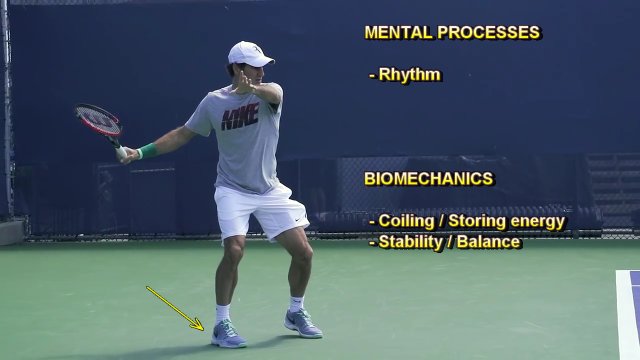
Third, the most important biomechanical element is body rotation into the shot, especially initiating through the hip rotation. You must do it right, though; that means not over-rotating and not just hitting with your arm.

Fourth, you need to time your stroke so that you meet the ball in the right contact zone where your wrist and arm are aligned correctly. If you don’t hit the ball at the right distance from the body, the stroke won’t work reliably, and the hit will not be effortless.

And fifth, on a fundamental level of hitting groundstrokes, there is balance also at the end of the stroke. The player is not rushing to recover but is looking to complete the stroke movement before moving their feet again.

Roger Federer typically demonstrates all these elements including the balance at the end of the stroke perfectly, yet you likely never noticed them.
If we take a look at the backhand, we will see that the fundamentals are exactly the same; there is less rotation on the one-handed backhand, but the principle is the same.
We need the right rhythm of our movements with the incoming ball, we need a very stable base off which we will initiate our stroke, and we need to initiate the movement through the legs and body rotation with the hip again leading. Hip leading the body rotation is often overlooked yet so fundamental.

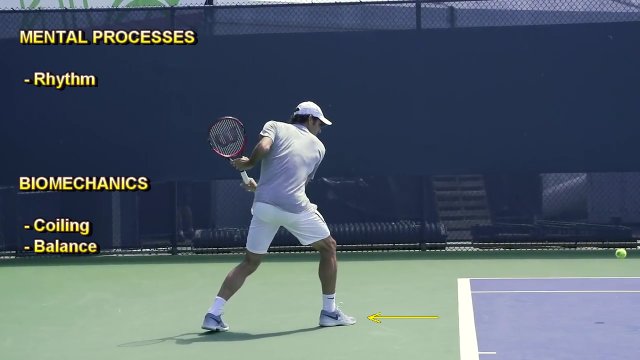

We need to time the ball so that we meet it in the ideal contact zone where the arm and the wrist are aligned properly, and we need to maintain balance at the end of the stroke.

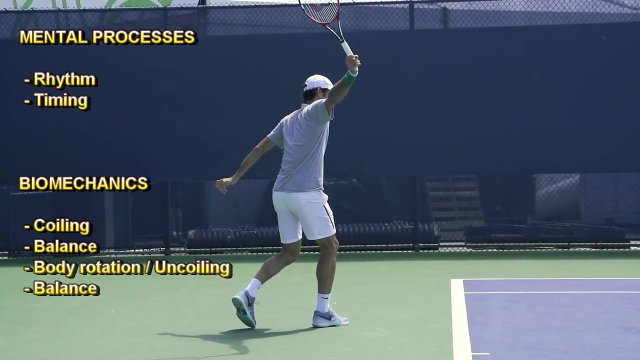
In my view and experience, these are the most crucial elements of a forehand or a backhand that must be done well; otherwise, the stroke will not be reliable or executed with effortless power, no matter the backswing’s shape, what grip the player uses, or what their follow-through looks like.
The Body Box And The Swing Box
I’d like to show you another way of looking at the groundstroke fundamentals, and we’ll use a neutral stance this time and a different view. The fundamentals are obviously generally the same of those used with either neutral or open stance strokes.
Note the two boxes: The first one points out the body area, and the second one highlights the initial swing area from backswing to contact, which is what matters most in the swing.
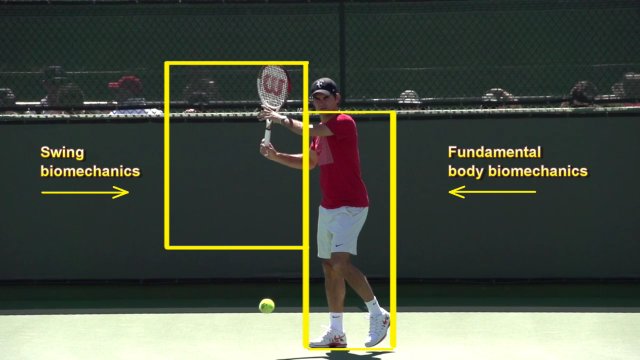
The biomechanical fundamentals happen within the body box.
This is the part that needs to be executed correctly, but most players and coaches pay the least attention to this aspect.
As you can see, I marked Swing Style as Priority #4, and you’ll see why in a minute.
So, as we observe Roger begin executing the forehand, we need to pay attention to the sequence of events.
If you’re slowly starting to agree with me about the importance of the biomechanical fundamentals and that they are more important than swing techniques, then we need to first pay attention to the sequence of events in the body box as those will also give us the priority of importance and priority of correcting the player.
Balance/stability obviously comes first. The foot is firmly planted on the ground and acts as an anchor while the leg acts as an axis around which the player rotates their body.

The second action in the sequence is the hip rotation, which initiates the body rotation.

With most players, the hip rotation is missing as their whole effort goes into the arm swing. The kinetic chain is therefore broken, and there is no power transfer to the arm.
The final part of the body rotation is the shoulder rotation, which acts as the final lever and enables us to swing the arm effortlessly off one of its ends.

This is the sequence of events that happen in the body. In my view, this sequence actually suggests to us what is the priority in corrections we need to work on with the player..
I believe that swing corrections should come only after we have corrected the main biomechanical fundamentals, no matter how much it annoys us to see an incorrect swing.
What must annoy the coach the most is if their player is not stable and does not rotate their body into the shot.
Most of the incorrect arm movements are, in my opinion, compensations for lack of balance and lack of power from the body.
Once we re-establish the balance and body rotation, the arm movements tend to correct themselves mostly subconsciously as the brain finds more efficient ways to swing the arm and coordinate it with the body movements.
Examples Of Correcting The Fundamentals First
Here are some examples of before and after clips of recreational tennis players who took lessons with me over the course of a few hours or a few days.
They all struggled with controlling the ball’s direction and, of course, were not able to hit the ball effortlessly.
They thought I would fix their technique, but I worked on their balance, body rotation, and contact zone.
Note how little – if at all – the swing technique of the players changed yet how much better their whole stroke looks now.
The players control the ball much better because they have much better control of their body and therefore much better control of their racket head.
They get more power from the body and can relax their arm more, swing it more, and get more easy power.
Improving tennis technique and the overall game of adult recreational tennis players is very difficult because they have years of bad habits.
That’s why I am showing you these examples and not how well a 10-year-old junior tennis player improved. These younger players are much easier to mold and correct.
My advice to all coaches and players who work on their game themselves is to first make sure the fundamentals are rock solid before working on some more advanced techniques and little details of the strokes.
As a side note: If you’re following an online tennis coach or two and they just talk and analyze but never show you any before and after clips of their students, then be very careful as talking is easy but teaching is very difficult.
As we all know, there are a lot of talkers out there and very few doers.
Why You Missed The Fundamentals
By now, you may be wondering why you missed the fundamentals since you’ve been studying tennis technique for quite some time through YouTube slow motion videos of tennis players and by following various tennis coaches who analyze technique online.
Here are the main reasons I can think of:
1 Your eyes are naturally drawn to moving objects.
What naturally draws your eyes?
Here’s my guess – I think they are drawn to this area marked with yellow lines.

Our eyes are naturally drawn to the most shiny object that moves the most, and that will result in you observing the racket path and arm and wrist action for the thousandth time.
While your eyes are glued to the racket moving through space, you fail to notice what the foot is doing.
By studying the wrist lag technique again, you fail to see what the hip is doing.
And, by focusing on the racket and looking at the smallest details in the follow-through, you fail to see a stable foot and perfect balance at the end of the stroke.
Please take a look at a series of videos I published some time ago where the racket was digitally removed from players’ hands.
This link to Tennis Illusions will take you to the category of video articles that include Roger Federer’s forehand and serve, Milos Raonic volley, Grigor Dimitrov one-handed backhand and Fernando Verdasco two-handed backhand.
The purpose of these videos is to take your focus away from the racket path and focus on body and arm movements. In other words, to retrain your eye…2 You observe and analyze tennis pros in match situations.
If you observe a tennis player in match situations, you’ll see many different adjustments of technique.
All these complex and different movements create less and less clarity on what you should be doing if you’re trying to solve your own stroke problems.
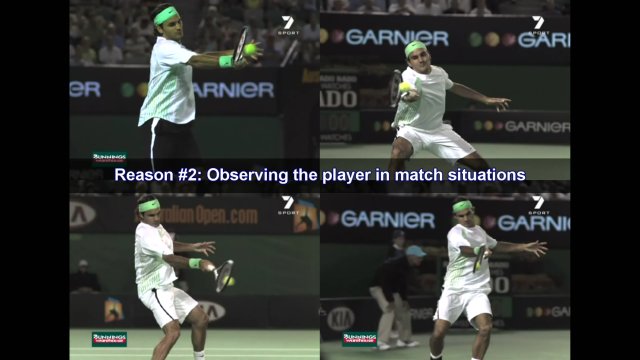
The main mistake here is that you’re looking at the player in a match where they are often stretched to the limit and have to execute a stroke in any way possible to return the ball.
As you’ve seen in the beginning, if you want to observe technical fundamentals of the pros, you need to look at them in the warm-ups and analyze them from the ground up.
3 You analyze personal playing styles (not realizing that that’s a mistake).
One of the main reasons you may have missed the fundamentals is that you analyze a personal playing style instead of biomechanical fundamentals of the stroke.

All four of these players have won a Grand Slam. Federer and Nadal have won the most, of course, so obviously they are the best of the best.
Yet, even in the initial preparation of the stroke, we can spend hours analyzing all the little details and differences in their wrist positions. When you focus on little details, you miss the big picture.
If you compare contact positions and later follow-throughs, you can again find many differences that add to your confusion regarding the right stroke technique.
To better understand why personal playing styles are not the answer and why you should actually look for commonalities and not differences in strokes, let me give you one analogy…
Tennis Fundamentals and Cars Analogy
Looking at the different personal playing styles of players is like looking at different car designs.
I know Roger Federer is an ambassador for Mercedes Benz, I remember Andy Murray driving a Jaguar I-Pace, I think Juan Martin Del Potro has a sponsorship deal with Peugeot, and Rafael Nadal has been endorsing Kia Motors, so let’s give him a nice Kia Stinger model.
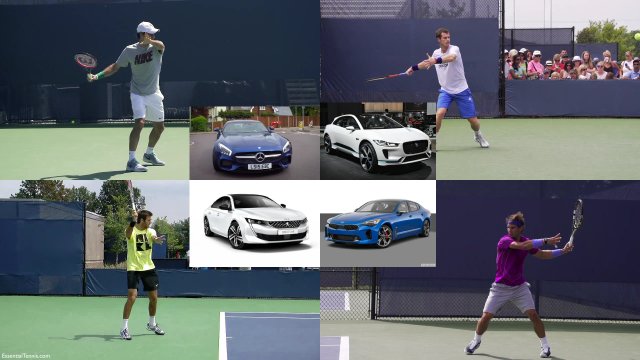
So, let me get straight to the point: If your forehand is not very effective and you try to improve it by copying the forehand style of a specific player, that’s the same as taking your car to the body shop to change its shape or paint it in order to correct its engine problems.
Changing its appearance will not make it faster or more stable.
The reason Roger’s Mercedes drives so well is not much related to how it’s shaped.
It drives well because it has modern technology undercarriage, multi-link suspension, perhaps four-wheel drive, and many other high-tech systems that give it great stability and handling.

It also has a modern 6- or 8-valve twin turbo engine that very efficiently and effortlessly produces power with relatively low consumption.
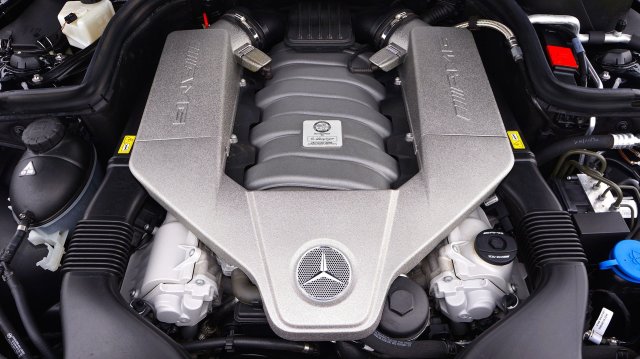
Both undercarriage and engine are hidden from our eyes, yet they are the biggest reasons why driving that Mercedes feels so comfortable and effortless.
The shape of the car adds only a little bit to its performance because of its low air drag coefficient.

Body and suspension of the car with wheel and engine Undercarriage with bodycar in detail isolated on blue gradient background 3d
Your goal as a tennis player is to understand which part of your forehand stroke corresponds to the undercarriage and the engine as they are the key to effortless power and comfort.

You can probably see the analogy: The car’s undercarriage and suspension have a similar function to the body’s stability and balance, and the car’s engine, where the power is produced, corresponds to the uncoiling and body rotation into the shot.

The consistency of your strokes lies in your ability to balance yourself during play, and the power of your strokes depends on your ability to engage your body rotation into the shot.
Your arm, of course, contributes to power, but it’s not the main source of it.
The arm corresponds instead to a steering wheel, which communicates with the wheels in the car. Both allow us to direct a tennis ball or a car in the direction we want.
So, the next time you’re struggling with your strokes and you’re analyzing a tennis pro to see what they do to hit with such effortless power and control, try to figure out where they get such stability of the body during their strokes and how and where in their body they generate power.
Retrain your eyes so that they stop following the racket all the time and pay attention to all other body parts from the ground up. You’ll start noticing many new and interesting aspects of tennis strokes.
Summary
In my view, the biomechanical fundamentals are a priority when we start correcting a player’s technique.
We need to start with stability, then make sure the large body segments function correctly during the stroke.
Only then can we address the flaws in the swing and start tinkering with the lag techniques and so on.
This does not mean that balance and body rotation are the only things to correct and that we never address the flaws in the swing techniques.
It just means that fundamentals (remember the body box?) need to be corrected first, and everything else should be addressed second.
Stay tuned for the next series of videos where I will address and explain each fundamental separately.




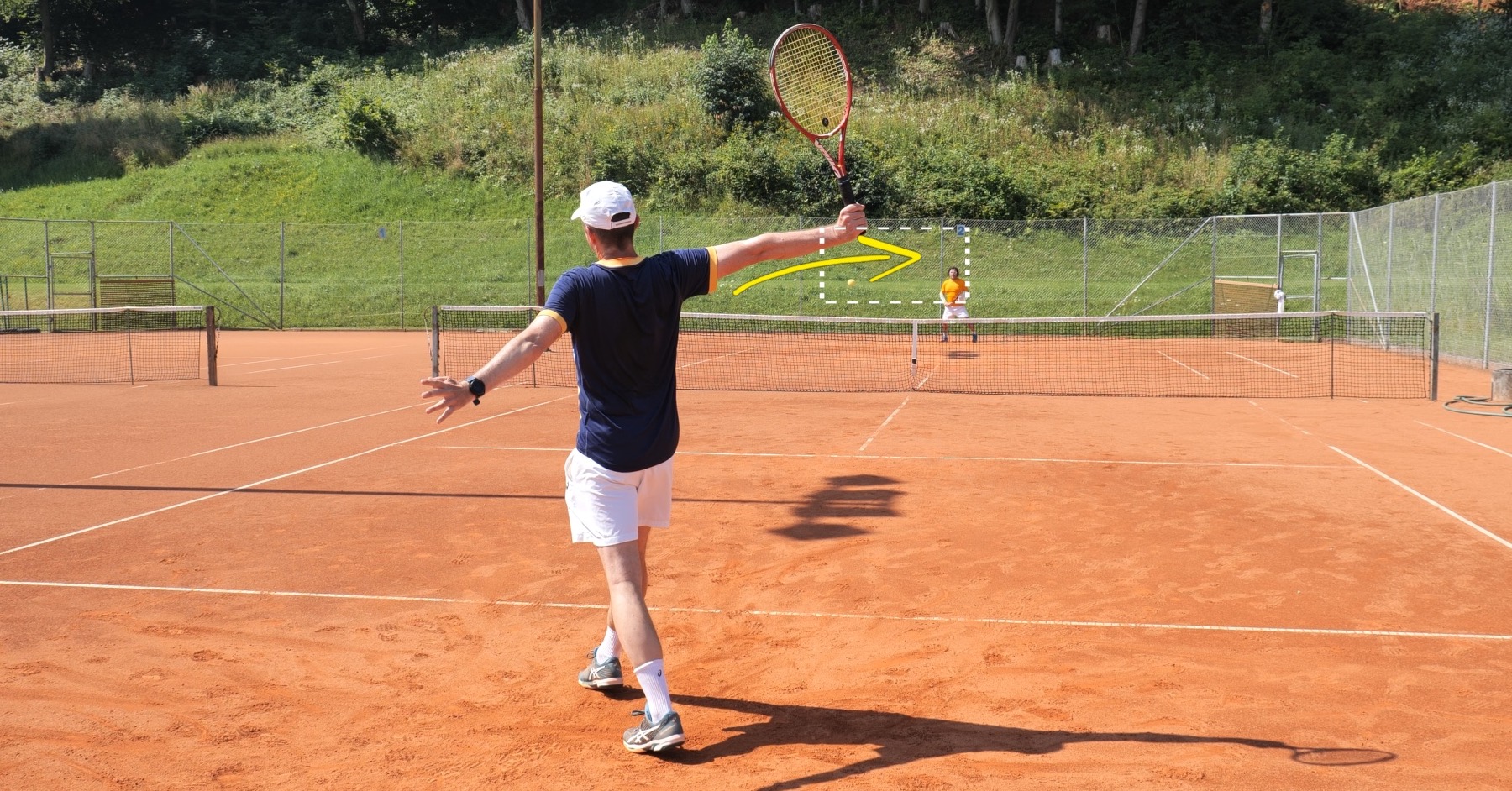
Hi Tomaz, I always love your insight on the game which has helped me greatly. I always try to follow your advice and many times I can but my technique breaks down once I start playing, once I am in a point playing situation. My form and technique is ok when I am hitting with my coach but once I am in a game situation I forget to maintain form. Any suggestions how I can become more unconsciously competent? Your truly, Wimbledon 2917 with you and Mark.
Hey Calvin,
If you “forget” your form in matches, it simply means it has not been automated yet.
There is no need to remember form in matches, it needs to become subconscious.
If it’s not yet, you need more repetition. And yes, I understand that the massive amount of repetition we need to ingrain movements is scary.
You should try and play some practice points and even practice matches and perhaps look to monitor your form there.
Also, if you’re trying to execute a certain “technique” or movement that a coach is teaching you, and you don’t DISTINCTLY FEEL its advantage, then that form may not be right.
A “correct” technique will feel so much better that you should have no problem “remembering it”…
Very scientific and refreshing approach. Planning to focus on the Body Box more. Thanks a lot
Wow, this is fantastic! When I watch tennis, I’m going to start watching the pros to look for (1) similarities, not differences; (2) the body box – everything but the racquet, arm, and ball – so I can see how they maintain rhythm, balance, and stability.
Thank you!!
Very welcome, Spencer, let us know what you notice!
I spent some time watching pros – tried to only focus on the body box.
(1) It is really hard! My eye keeps chasing the ball and racquet. (Exactly your point.)
(2) They look SO similar! Many of the pros are very difficult to tell apart, if all you watch is the body box. (Which, again, is your point – let’s focus on the fundamentals that they are all doing well instead of looking at superficial differences.)
(3) They look like dancers. Calm and stable whether they are moving quickly or slowly. Great rhythm.
What will happen if, when I play, I think less about the racquet path (which is normally about 90% of my focus) and more on the body? I’m going to try to visualize the undercarriage of a car…
Many thanks, Tomaz! This is not just great stuff but also really fun.
Spencer
Thanks for the feedback, Spencer!
And yes, the eyes focus on the ball way too much, that’s always a problem in lessons as I want a player to focus on a new body movement that we’re trying to incorporate and yet their focus keeps going to their shot.
So yes, focus on being stable and rotating / turning into the ball while maintaining good stability.
If you can add to that a nice relaxed swing of the arm then you’ll be on the right track.
https://www.feeltennis.net/universal-swing/
Thank you!!
Nice explanation and video Tomaz. I’m glad you and others are focusing more on the kinetic chain aspects of the swing where there’s a wind up and then a ‘release’/ throw of the racket towards the contact point .. with the swing path/ follow thru just happening naturally from the initiation of the swing.
Way too much emphasis in most instruction on the segmented/ slow-motion break-down of the racket path when that’s not what ANY good player does. It’s why you see so many ‘muscling’ their strokes and trying to get extra power and spin solely by weight transfer and body rotation rather than by generating additional power/ spin/ energy by using a whip action that takes advantage of centrifugal force and concentrates energy at the tip of the lever (the racket head).
I’ll note that the ‘before and after’ clips of your students demonstrate improvement mainly due to better balance, timing, footwork and weight transfer, but they’re pretty much all executing ‘old-school’ swings that have not (yet) incorporated the ‘whip action’ of more modern swings that allow for the generation of additional power and spin with less body weight transfer and pendulum action from the swing.
Of course you can execute ‘pretty’ and effective swings in this old-school manner when an instructor is just feeding you perfect balls, but this old school method is harder to implement effectively in match play when the balls aren’t being fed at a consistent pace and depth, etc. A big advantage of the more modern ‘whip action’ strokes is the ability to be more improvisational and also the ability to generate pace from slow balls and balls at different levels/ strike zones.
Hi BB3,
I would say that whip action is not attainable to recreational tennis player and should not be taught.
A player can only execute reliable whip action if their timing is excellent. Recreational players’ timing is 100x worse than that of a skilled player.
Even I do not use a whip action on the forehand.
I also disagree that a whip action is easier used in match situations.
I would argue that it’s much harder to implement as it’s a more complex motion that needs to be coordinated with footwork.
If we’re talking about rec players, then coordination is surely very poor.
A simple swing is very easy to implement into movement and it gives more than enough power to play.
A whip action can produce more power but how will a rec player control it?
It’s like giving a Ferrari to someone who is used to driving at city speed limits with their Prius.
Is Ferrari a more powerful car than a Prius? Yes. Can a non-skilled driver control it? Not at all.
It takes years of practice to master controlling the car at high speeds.
The same applies for extreme accelerations of the racket head.
And lastly, when adult rec players with 5-20 years of ingrained muscle memory come for lessons, it is almost impossible to change their “stroke technique”.
I can correct a player in a matter of days (3-5) when focusing on balance, body rotation and adding some swinging feeling to their strokes.
This is more than enough for their needs as I play with such simple technique too and I am likely a 5.5 player.
If you can correct their swing techniques and add a lag techniques and make them play consistently in a matter of days, then please show you results and explain how you do it.
If you cannot, then none of your opinions really matters.
The only thing that matters is a “before & after” proof shown with a multitude of players.
guess we’ll have to agree to disagree. everyone of the pros that you highlight – including Delpo – use a whip action in all their strokes – as does basically every half-way decent junior player – including the junior players that I’ve seen in videos from Singapore (I think). I’m not saying you have to go full Jack Sock or Kyrios – but adding a whip/throwing action to every stroke makes the stroke more efficient as well as more powerful because you accelerate through the strike point more quickly – meaning that you can have shorter backswing and – as I stated earlier – you can generate effective shots from otherwise difficult positions where you don’t have the ability .. and time .. to measure and step into shots.
You have some whip in your FH and BH .. and you had a video awhile ago where you demonstrated the difference between what you do vs. an old school
McEnroe FH – your FH being closer to Delpo than Nadal or Joker or Sock/Kyrios for sure – but still some throwing aspect to it.
And again – most every decent player incorporates this now because it’s easier and more efficient than ‘old school’ strokes – which require more perfect timing and weight transfer and which stress the arm because you are ‘muscling’ the shot rather than just winding up and ‘releasing’ the racket to/thru the contact point.
Coil and release .. and it’s the same on a FH, BH (uncoiling like a frisbee throw) and serve .. and when Fed makes it ‘look easy’ during warm-ups .. that’s because it is .. easy on the arm .. easy to time .. easy to generate power and spin. Now when he’s full go during a match and moving to the BH side to unload on an inside out FH – yeah he really explodes into the shot, but the basic stroke is consistent because it’s a very natural swing .. just coil and release.
Depends a bit on what you mean by a “decent” player and what you mean by “whip.” Tomaz’ point — with which I agree — is that many/most recreational players are more likely to make mistakes by trying to incorporate a more advanced technique. I’m a 3.5 – 4.0 and I find greater success when I focus on trying to hit simple, repeatable strokes and have less success when I try to “whip”ground strokes or try other more advanced techniques. And Thomas’ point about adult players’ habits and muscle memory are spot on (at least in my experience).
Hi Hal,
Sure, we need to define the “whip”. In my view, Federer whips the racket through his wrist / forearm and Simona Halep doesn’t.
https://www.feeltennis.net/forehand-wrist-lag/
I do not recommend Federer technique to recreational tennis players especially not trying to “learn” it.
I think even just this picture tells you why:
The wrist lag / whip will unconsciously develop as the player relaxes more over time and if they are skilled enough in athletic department and have good enough timing.
Again, BB3, the pros don’t matter, the competitive juniors don’t matter as 95% of the readers of this blog are recreational tennis players typically playing twice a week.
I work with them every day. I know exactly what their are capable of.
The only thing that matters is what they are actually capable of achieving and not what is theoretically the best.
You are saying “just coil and release”.
Please show me how you teach in that in a matter of days to a dentist, a lawyer, a stock brocker or another “non-athletic” person who did not train any sport with balls in their childhood and have decided at the age of 40 that they are going to play tennis now.
They play once or twice a week and the rest of the time they spend sitting. (in the office, in the car, on the couch)
And they do not play with balls in their spare time playing some table tennis or badminton or volleyball.
If you can show me your results with such people, then I am all ears.
If you cannot, then we cannot have a debate as I produce results and you don’t.
You only have theoretical opinions which have nothing to do with reality.
Right on Tomaz. I have been trying to adapt my 20 year muscle memory serve for 4 years. Remember the 10,000 hour rule for perfection: it is simply a matter of practicing a specific task that can be accomplished with 20 hours of work a week for 10 years.
Very clear and concise explanation of the biomechanics. Thank you. Look forward to the future video
Thanks. I have helped my partner to improve a lot with your biomechanical approach (and my own shots as well). One thing that we are still working on is finding the right rhythm – essentially how to initiate the move to the ball consistently so that you are in a position to hit from balance as shown in the video. Would love to see a video on that.
Thanks, Ilja.
Are you referring to the movement to the ball with your feet or an initial movement of the stroke preparation?
Getting into the right position to the ball requires very good ball judgement.
If we’re talking about a typical rec player playing twice a week, then ball judgment is definitely not on a high level and therefore positioning also cannot be good.
Initial movement. It seems key is to have ‘consistent’ footwork approach in order to have smooth transition to initial coil.
Thanks. Great explanation and observation. Looking forward to the rest of this series. Do you have general footwork video somewhere?
Thanks, Sam.
I shared this so far on the site regarding the footwork:
https://www.feeltennis.net/basics-of-tennis-footwork/
https://www.feeltennis.net/footwork-small-steps-myth/
Also this is important:
https://www.feeltennis.net/neutral-open-stance/
I don’t have a footwork course yet but I do include the most common footwork patters in my paid courses. (forehand, backhand)
Excellent video pointing out where we focus and why we miss the fundamentals. After the part showing the differences in strokes, I expected you to point out the similarities in feet and hips. Maybe next video…
Hi Lisa,
The similarities are there for you too see. Every pro sets up their feet in a very similar manner and rotates their body in a similar manner.
It’s just that our mind naturally focuses on differences. You need to retrain it to look for similarities.
So look up any pro on Youtube in their warm up session and observe from the ground up what they do.
Ignore the racket and see what they do.
Thanks for the excellent article and timely reminder to focus on these fundamentals. As you mentioned in your article I am one of those players who views multiple tennis videos and focuses overly much on stroke technique (eg am I doing a proper windshield wiper follow through)? But thinking about my results when on court, there’s little question but that balance and biomechanics are more important. Thx again.
Hi Tomas
This is great. Can’t wait for the rest of the videos. I’ve been working on my hip rotation for several months now. When I get it right there’s SO MUCH effortless overpowering of my opponent!
Your car analogy makes total sense. Here’s a video that’s helped me understand that the body is a fulcrum to the arms. https://www.youtube.com/watch?v=MMoUf2mgrP8
Would love to know your thoughts.
Best
Guy Moses Vidal
Love the analogy, can relate alot to this 🙂
Truly appreciate your approach Tomaz, back to fundamentals is essential. After about 15 years of online information avalanches, four words stick in my mind: ‘Split Step, Unit Turn’. I have never heard a Belgian coach say this.
I love this technic.
Excellent Tomaz, You’re my go to online site for all my students. Greg USPTA
Using the “slo-mo” video recording option on most smart phones will allow a player to see the validity of your findings. Thanks for your excellent analysis, Tomaz.
Grate thanks Tomaz, perfect lessons. I was surprised with examples you gave. Video was as a book for me.
Once again, clearly and simply explained in video (and written) format, Tomaz. Love the auto analogies. Thank you for your efforts in helping the rec player get more enjoyment and playing satisfaction out of this awesome game. Beginning to understand why I hit and seem to “get little out of the shot.”
Glad to hear the auto analogies makes sense!
Tomaz,
I really enjoyed watching your video. I have benefited from your inputs since they go beyond the typical coaching that I have experienced. Most pros focus on technique but omit the fundamental of the sport which is the proper balance and footwork. My question for you is how do I rotate my hips correctly for the best results. Thank you very much for all your hard work. Sophia
Thanks, Sophia!
Learning hip rotation is tricky. Your first step is to observe carefully the hip / pelvis region of players are they warm up in neutral and open stances.
When you have a clear image, you can try and replicate that.
It’s tricky to do it just off a visual image.
I will share some ideas for free but in my Forehand and Backhand courses I share practical drills with elastic bands and other tools on how to wake up and stimulate the hips that they start engaging.
Thanks Tomaz, next week I am now inspired to begin videoing myself hitting to take a look at my undercarriage and engine parts in action haha Cheers
Wonderful, please let you know what you discover! 😉
Hello Tomaz, great and excellent explanation on the fundamental bases of the different tennis strokes.
Biomechanics, along with looking at the ball and the ideal contact point, it is almost everything a club player needs to know.
Obviously you need a good physical condition. With this you can have a lot of fun, to compete you also need a particular mental process.
Thank you very much for your teachings.
Greetings.
As an ITN 3.8 to 4.3 player I found your page yesterday and already tried a few things on court. Especially the slow acceleration of the swing instead of starting the swing in an explotion helped a lot to improve my ground strokes and serve. Since my shoulder is hurting for over 15 years now that even helps me to get some speed without pain. The other thing was the hitting high balls article. I was totally surprised how easy it is to get it done on the court. A bit more drills and I am 100% sure that I will improve. Thank you a lot and many greetings from Austria. Whenever I am in your area I hope I will remember and drop in for a few lessons if you have the time.
Thanks for the kind feedback, Michael! Enjoy tennis and keep in touch!